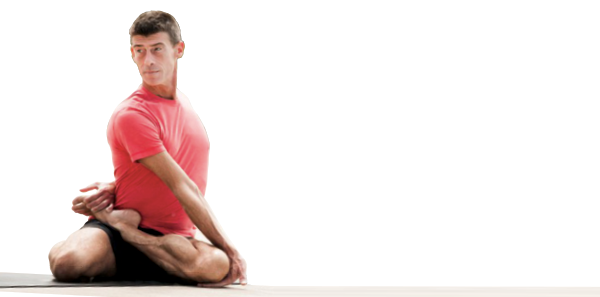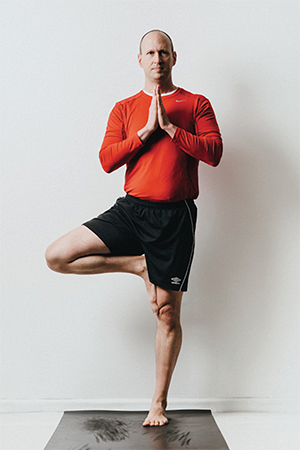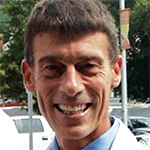
Fifteen minutes into my first yoga class, I [Dr. Balentine] quickly wondered what I had gotten myself into. I am a fairly open-minded individual and was looking for an alternative way to exercise. We, as emergency physicians, are all keenly aware of the stresses that are inherent to our profession, and I am not immune.1 What could be more relaxing than sitting around in a circle and chanting “om”? I needed a break from the surrounding clinical symphony of alarms, beeps, and interruptions.
Explore This Issue
ACEP Now: Vol 34 – No 09 – September 2015After some basic stretches, the small class stood in a circle. The instructor gestured to someone near me who responded, “Sun,” as if that was his new name. The person next to me responded, “Moon.” It was now my turn. “Uh, Bryan” was my response. A few giggles followed in the room. Apparently, we were standing in a circle that did not allow everyone to spread their arms and then touch their toes at the same time without bumping into a neighbor. Alternating the stretch (Sun and Moon) next to your neighbor prevented “full-contact” yoga. I smiled.
Two years later, I’ve developed a deeper appreciation for yoga, flexibility, and a greater ability to simply relax in most situations. I could not remember the last time I could touch my toes, but now I can—and grab the bottom of my feet. From a practical standpoint, my 43-year-old body can hop up from the floor easier after playing with my young children. Clinically, I am more aware of posture while sitting at work. My chair angles at 90 degrees rather than the previous somewhat reclining position and kyphotic posture. How many patients with back pain do you see a day with surgical histories? I like my spine without scars.
Practicing yoga in an everyday setting can be as simple as noticing and observing one’s posture when seated, standing, or even lying down. For physicians, being mindful of how weighted down their white coats are can be a form of yoga. To lighten the lab coat and decrease the forward shoulder pull and subsequent kyphosis is, in a sense, practicing yoga.
While I benefit from numerous yoga instructors, I spend more time with Shawn Galin, PhD. He is course director for endocrinology at the local medical school and an associate professor of critical care medicine, and he enjoys a passion for yoga. I learned of his background in medical education just before joining the ACEP Well-Being Committee. After sharing my experiences with him on how yoga positively impacted me at work and home, we shared articles and research. PubMed contains almost 3,000 articles on yoga, but our goal in collaboration is to focus on a few areas that can impact you now.2,3
The Breath and Stress

Dr. Balentine in tree pose.
As in life, proper breathing is very important in yoga practice.4,5 In fact, the ability to breathe properly and control one’s breath can have profound effects on both mental and physical status. When the breath is shallow, a common side effect of stress, blood is not oxygenated properly, which impairs mental function and promotes physical fatigue. Stress can cause shortness of breath and anxiety. These changes in breathing patterns are mediated through the sympathetic nervous system as part of the fight-or-flight response.6,7 As you get more anxious, your breathing muscles fatigue and cause even more shortness of breath and anxiety. Thus, stress can create a vicious, perpetuating cycle.
Most yoga classes focus on breathing techniques, or pranayama, that help practitioners slow down their breath. A recent article in The Wall Street Journal titled “Breathing for Your Better Health” reports the benefits of abdominal breathing and notes that they are the direct result of vagal stimulation.8 Slower breathing stimulates the vagus nerve, which runs from the brainstem to the abdomen. The vagus nerve, as part of the parasympathetic nervous system, is responsible for the body’s rest-and-digest activities. In contrast, rapid, shallow breathing is associated with the sympathetic nervous system. The article goes on to report that vagus nerve activity can cause the heart rate to decrease as we increase the length of our exhalations. This is, in part, due to the vagus nerve’s release of acetylcholine, which slows down heart rate and digestion.9 This highly suggests people can actually alter their physiological response to stress simply by altering their breathing. Taking long, deep breaths with conscious observation of the length of exhalation can promote vagal stimulation, resulting in a sense of calm rather than chaos.
Posture
Although meditation and pranayama are core components to the practice, yoga is more commonly associated with asanas, or postures. There is a common misconception that people need to be flexible in order to attend a yoga class when, in fact, the opposite is true. Yoga is designed to increase both strength and flexibility by synchronizing breathing with physical movement through various postures. It is not uncommon for someone to notice an improvement in posture within weeks of starting a yoga practice.10
Noticing postural habits soon becomes second nature to a yoga practitioner. Standing taller, sitting up straighter, and walking with a straight spine are all common benefits of a regular yoga practice. Practicing yoga in an everyday setting can be as simple as noticing and observing one’s posture when seated, standing, or even lying down. For physicians, being mindful of how weighted down their white coats are can be a form of yoga. To lighten the lab coat and decrease the forward shoulder pull and subsequent kyphosis is, in a sense, practicing yoga.
My growing yoga practice triggered a wonderful journey, from a comical introductory class where I thought I would receive a new celestial name to networking with PhDs in endocrinology and joining the ACEP Well-Being Committee. The ever-apparent stresses of our profession levy a remarkable toll on our wellness unless an appropriate negating response is initiated. While I do not exist in a constant calm mode at work, yoga allows me to relax more, provide better care, and extend my longevity in medicine.
 Dr. Bryan Balentine is a practicing emergency physician at UAB Medical West outside of Birmingham, Alabama.
Dr. Bryan Balentine is a practicing emergency physician at UAB Medical West outside of Birmingham, Alabama.
 Dr. Shawn Galin is an associate professor in the department of medicine at University of Alabama at Birmingham.
Dr. Shawn Galin is an associate professor in the department of medicine at University of Alabama at Birmingham.
References
- Arora M, Asha S, Chinnappa J, et al. Review article: burnout in emergency medicine physicians. Emerg Med Australas. 2013;25:491-495.
- Sharma P, Thaplival A, Chandra T, et al. Rhythmic breathing: immunological, biochemical, and physiological effects on health. Adv Mind Body Med. 2015;29:18-25.
- Greendale GA, Huang MH, Karlamangla AS, et al. Yoga decreases kyphosis in senior women and men with adult-onset hyperkyphosis: results of a randomized controlled trial. J Am Geriatr Soc. 2009;57:1569-1579.
- Holcombe K. Breathe easy: relax with pranayama. Yoga Journal Web site. Accessed August 13, 2015.
- Mitchell L. Eight reasons why we use ujjayi breath in yoga. Mindbodygreen Web site. Accessed August 13, 2015.
- Sarubin N, Nothdurfter C, Schüle C, et al. The influence of Hatha yoga as an add-on treatment in major depression on hypothalamic-pituitary-adrenal axis activity: a randomized trial. J Phsychiatr Res. 2014;53:76-83.
- Ross A, Thomas S. The health benefits of yoga and exercise: a review of comparison studies. J Altern Complement Med. 2010;16:3-12.
- Reddy S. Breathing for your better health: controlling your breath is an easy way to improve mental and physical health. The Wall Street Journal Web site. Accessed August 13, 2015.
- Noble MI. Abraham Guz memorial: still unresolved hypotheses: lung reflexes and perceptions of breathing. Respir Physiol Neurobiol. 2015;217:46-53.
- Yoga for the back: improving posture can improve your long-term health. Yoga U Web site. Accessed August 13, 2015.
Pages: 1 2 3 | Multi-Page



2 Responses to “Benefits of Yoga for Emergency Physicians”
September 23, 2015
Thomas BalentineI am impressed by my son’s participation with yoga classes. I consider it surprising to both he and I as to the beneficial results of his interest in this type therapy. He continues to be sensitive to all physical, mental and spiritual aspects of health issues. This article even prompts a 74 year old senior to become better educated with the potential health improvement for my remaining years.
January 19, 2022
Grow PracticeThanks for sharing information about Benefits of Yoga for Emergency Physicians